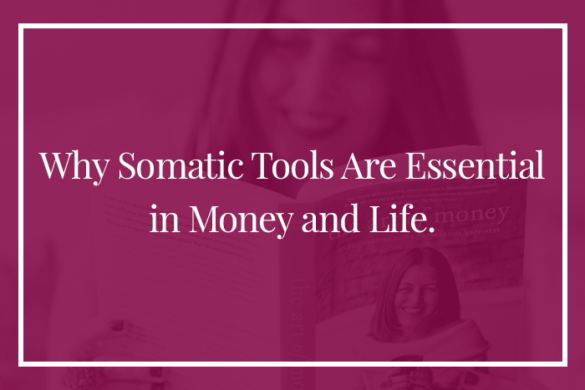Today’s article might bend your mind just a little bit — in a really good way! It’s about a side of money that I rarely focus on: the great, big, systems view of money … or what I call the “macro” side of money.
You see, my whole methodology starts with the individual — with YOU. I have a gift for feeling into the subtle nuances of an individual’s unique money journey: from the emotions and bodily sensations to simple practices to savvier business models.
Of course, doing our individual money work is powerful stuff — and not just for the individuals doing it. Tapping into your own money story can shift how you talk to your sweetie about money … which in turn might help him get a little gentler and braver when asking for a raise at work … which in turn inspires a few people who witness it … and on and on. This effect is powerful stuff and keeps me so inspired by the work I see you all doing.
But there’s a completely different way to look at money, too: the huge, systems-view, or “macro” way. This is where we zoom out further and further and further and start thinking about the national or global economy, how to create better financial institutions and systems of currency, and on and on.
This “macro” side of money isn’t my specialty, but it fascinates me. That’s why I love to listen to experts in the field. And today, I want to share a bit with you about what I’ve learned from one of them.
Don’t fret: the idea I want to introduce is actually very intuitive (and feminine!). And I know you’ll be able to recognize how it’s already operating in your life.
Meet my “macro” money mentor: Bernard Lietaer.
The first time I heard Bernard speak, I sat back in complete awe. I was hooked.
This was back in 2005 at a Financial Planning symposium in Estes Park where we were both presenting. It was my first time sharing my work with this seasoned community, which was exciting and terrifying. (I even did a cartwheel in the opening introduction!)
Bernard is kind of a big deal. He’s an economist, philosopher, visionary, author … and creator of the Euro money system.
I had the great pleasure of having lunch with Bernard twice after that first meeting. He was living in Boulder at the time, holding the World Wisdom Chair at Naropa University (my alma mater). Since then, he moved back to Belgium, but I’ve followed his work and books ever since.
Bernard’s work blows me away and has really shaped my perspective on the macro side of money. Not only has he opened my eyes to brand-new ideas, he’s also named things I’ve felt and noticed my whole life.
What’s a “Complementary Currency”?
So, we’re all familiar with standard currencies. The American dollar, the Japanese yen, the European euro. But there are also other, complementary currencies in addition to all these. I’m not just talking about BitCoin (which is an alternative, cryptocurrency). I’m talking about money systems that operate on a completely different philosophy: yin currency.
Here’s Bernard giving a great description of a complementary, yin currency in Japan:
Let’s say that on my street lives an elderly gentleman who is handicapped and cannot go shopping for himself. I do the shopping for him. I help him with food preparation. I help him with the ritual bath, which is very important in Japan. For this help, I get credits [called fureai kippu, or “caring relationship tickets”]. I put those credits in a savings account, and when I’m sick, I can have other people provide such services for me. Or I can electronically send my credits to my mother, who lives on the other side of the country, and somebody takes care of her.
Here is an agreement within a community to use as medium of payment something other than national currencies, to solve a social problem. And it makes it possible for hundreds of thousands of people to stay in their homes much longer than they otherwise could. Otherwise, you’d have to put most of these people into a home for seniors, which costs an arm and a leg to society, and they’re unhappy there. So nobody’s winning. In contrast, Japan has created a currency for elderly care.
But Japan doesn’t stop there. This complementary currency program, originally started to care for the elderly, has expanded to fulfill another need: paying for college tuition. That’s right: young people can take care of the elderly, receive “caring relationship tickets,” and spend these as partial payment for university tuition. How cool is that??
There are tons of these “complementary currencies” around the world, not just in Japan. Some are government-created and others are grassroots-initiated. These are related to another concept which Bernard introduced me to — which I LOVE — Yin and Yang Currencies.
Yin and Yang Currencies
This concept is something I’ve always felt, but never had the language for. That’s why I got so excited when Bernard described these two different styles of currency!
Most money that we’re familiar with is “yang currency.” According to Bernard, yang currency “promotes competition among the participants” and “are created through patriarchal values and society.” All of our current national monies (the American dollar, Japanese yen, etc.) are considered Yang Currencies.
Yin currency, on the other hand, is “all of our trades, barter, and time/energy exchanges.” Yin currency “promotes cooperation among participants, tend to occur in more ‘egalitarian’ gift societies, and is generated out of community needs and situations.” The “caring relationship ticket” system in Japan is an example of a yin currency.
What’s so interesting about yin and yang currencies is: they don’t fight each other, but work together! In fact, Bernard’s historical research shows example after example of cultures that had both yin and yang currency systems operating at the same time: a dual currency system.
Societies with dual money systems have tended to thrive … while societies that only have yang currency eventually crumbled into their greed and competition.
Bernard gives a great example of a dual currency system that’s alive and well today, in Bali. While the Balinese use a conventional (yang) national currency, practically all of them also use a second, yin currency, called “narayan banjar,” meaning “work for the common good of the community. This currency is created by the people themselves and its basic unit is a 3-hour chunk of time. This yin currency is used at the neighborhood and community scale. For example, if a community wants to launch a project, like putting on a festival or building a school, they always make two different budgets: one in the national currency and one in the yin currency. Bernard explains,
Here’s why it works: poor communities don’t have a lot of national currency, but they tend to have a lot of time. In rich communities, the opposite tends to be the case-people have more national currency, but less time. In either case, each banjar is capable of creating extraordinary events just by budgeting and using more of the kind of currency-national or time-in which they are rich. This balance is a key contribution to the unusually strong community spirit that prevails in Bali.
Why it (still) all starts with YOU
As I mentioned at the beginning of this article, I’ve always felt that my mission in this Art of Money work is to be a personal guide to you: the individuals, couples, and creative entrepreneurs navigating your money stories and initiations. So … how does this deeply personal money work mesh with the larger systems and macro views that Bernard Lietaer and others talk about?
During one of our lunches, Bernard explained to me the importance of awareness, when it comes to money, in words similar to these (from an interview):
Currently, our biggest problem with money and currencies is unconsciousness. We are not aware of what we are doing around money. We haven’t really thought about what money does to us. We believe it’s neutral, so it doesn’t matter. But it’s not neutral: it deeply shapes us and our societies. The first thing that has to happen before complementary currency systems can effect real change on a larger scale is a shift in consciousness and awareness.
These words have been a source of comfort to me over the years, and I hope they reassure you, too. It can be overwhelming to zoom out and look at the larger systems of finance and monetary exchange. How can you and I ever hope to effect change within something so big? Let us all be reassured that this money work — shining the lights of awareness, intention, and compassion on our money — actually is essential to solving our larger economic issues.
Here’s to you, to this work, and to the brilliance of visionaries like Bernard. It’s so exciting to see these disparate threads of money work twisting together and helping create the internal and external changes our world so desperately needs today.
Resources to Go Deeper:
1. The Future of Money: Creating New Wealth, Work and a Wiser World
2. Rethinking Money: How New Currencies Turn Scarcity into Prosperity
3. Creating Wealth: Growing Local Economies with Local Currencies





